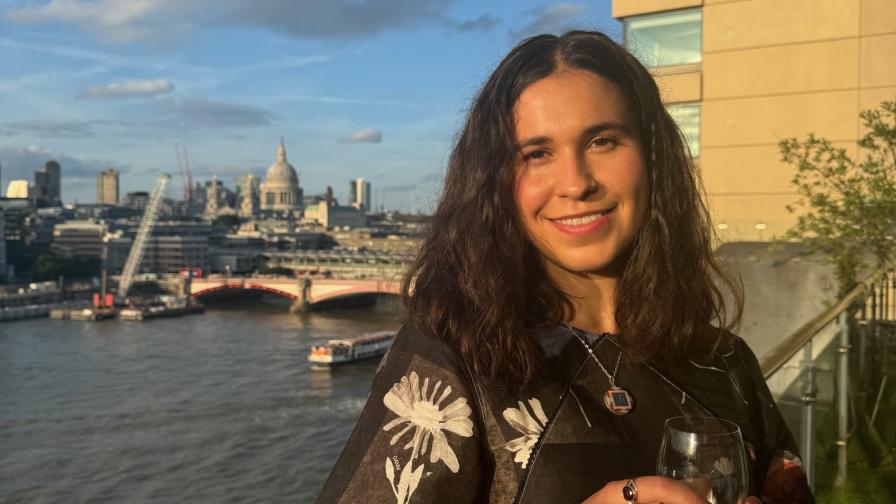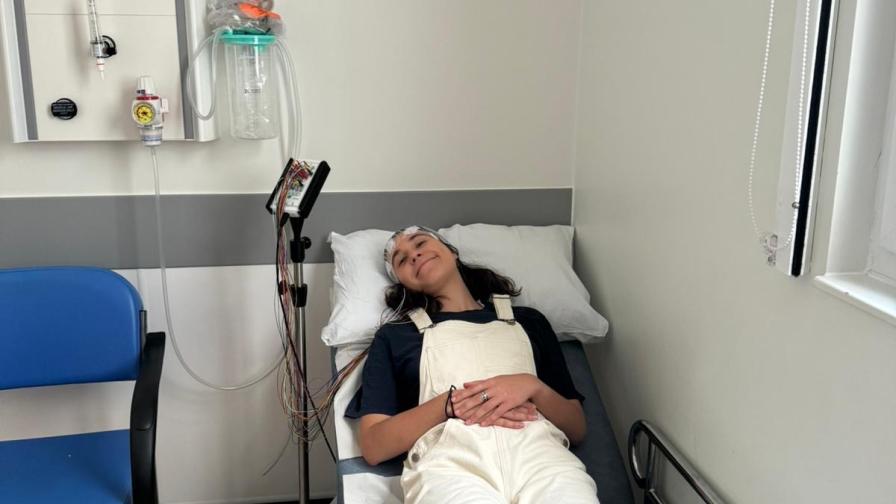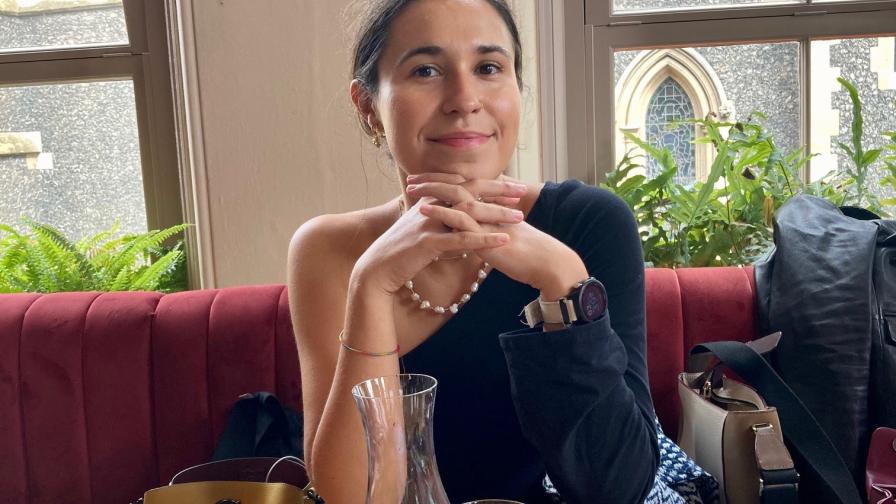Helena's story
Helena Napier is an illustrator, graphic designer and animator currently living and working in London. Here she shares how her temporal lobe epilepsy was undiagnosed for seven years and its impact on her.

When I was ten, we still went to church every week. Attending increased my chances of getting into a good secondary school. One Sunday, against the backdrop of a typical sermon, I was gripped by an unfamiliar feeling. It started off extremely pleasant, like deja-vu, rising from my stomach to my throat. Then the stench of petrol entered my nostrils and the altar ahead gave way to a different scene.
I ‘saw’ what I perceived to be an ocean of bones, each wrapped in its own individual green leaf. Hundreds of them swam together calmly under a stretch of clear blue sky. The pew my small fingers clung to dissolved, and I was plunged simultaneously into a sense of both total disorientation and incredible clarity. I started to cry and my Mum took me outside. ‘What’s wrong?’, she asked, but I couldn’t tell her. My ten-year-old self had just experienced her first seizure. It still feels strange to share something so private and so absurd. This remains my most tangible memory of an epileptic vision to date.
The episodes continued, stopping and starting. A month or two could pass as normal, followed by a flurry of seizures within a single day. I started to get used to them - even enjoy them. Eventually, we started to refer to them as ‘the Feeling’.
‘I’m getting the Feeling’, I’d tell my Mum, moments before my mouth refused to form the words to describe the images that washed over me, clear as day. They felt crucial, and I remember being desperate to communicate them before I knew my body would inevitably succumb to my mind and they’d be gone. Anyone looking at me would simply see a child staring into space for a few seconds or a few minutes. It didn’t look like anything out of the ordinary, but I quietly observed each divine reverie slip away before I could make any sense of it and waited in anticipation for the next.
I know now that medically, I was experiencing two types of epileptic seizures: focal onset aware seizures, the euphoric feeling known as a ‘warning aura’ (as it’s is usually often closely followed by a second seizure), and focal onset impaired awareness, where loss of consciousness and intangible visions replace any semblance of reality. A person with epilepsy will also experience the ‘postictal state’, a name given to the disorientating period that follows directly after a seizure. It’s accompanied by motor deficiencies such as unresponsiveness, headaches and memory loss. Untreated epilepsy is dangerous, as it can damage the brain. Yet, somehow, seven years passed before a formal diagnosis.
Not long after the episodes started, I got into an all-girls Catholic secondary school and addressing the Feeling was side-lined. There was pressure and there were hormones. We discovered social media, what it meant to look attractive and slurped cans of tepid beer on commons, pretending to enjoy the taste. Strong personalities and rumours were, for a short while, life’s main focuses. The feeling became my normality but always remained my Mother’s greatest frustration. I have her perseverance to thank for my diagnosis.
She insisted I went to the doctor, but the Feeling was impossible to describe, or I’d skip appointments out of embarrassment. Secretly, ashamedly, I relished how good the Feeling felt. When I was fourteen, I googled my symptoms and came across temporal lobe epilepsy and I knew I’d found my answer. Nothing much changed. One GP dismissed me and the other told me to write down my experiences and research depersonalisation disorder. Eventually, I was diagnosed with adolescent fainting spells.

Meanwhile, the seizures were so pervasive that they touched almost every aspect of my life. They destroyed my memory, and my ability to concentrate or study deteriorated. I was, more often than not, tired, or frustrated or disorientated. Trains of thought sped straight into neural storms. I was creative and bright, but I didn’t try because trying became too hard, and often got me nowhere.
This continued until I was seventeen. Around this time, my Mum dragged me to see a neurologist. This particular doctor listened intently, leaning forward and nodding at the self-conscious teenager who described blissful hallucinations and imaginary smells. I’ll never forget her: she didn’t brush it off as adolescent rubbish or take offence because I’d investigated the condition myself. Instead, she promised me we’d ‘get to the bottom of this’. Very quickly, life became a blur of appointments and scans.
I was referred for ‘video telemetry’, a lengthy sleep-deprived EEG scan at Charing Cross hospital. I sat in bed laughing as doctors glued colourful wires to my head and secured them with a hair net. For five nights, nurses shook me awake in the middle of the night, offering issues of Glamour magazine and reality TV as consolidation. Lack of sleep puts the mind under stress, which is more likely to trigger epileptic seizures in patients who are affected. As friends visited and I ate sloppy mushroom pasta off the NHS menu, I waited for the familiar Feeling to embrace me, but I left the hospital feeling disappointed. We were convinced that doctors would find no explanation, and that I’d be in the dark all over again.
Abnormal neurone activity was spotted in my results and a letter explaining I was suffering from temporal lobe epilepsy came through the letter box.
I remember crying in PE in the days afterwards – my new medication made me tired, and I was sad I wouldn’t be able to drive. I also felt like damaged goods. But the news also brought giddy relief and a funny sense of absolution. I never described a seizure as a Feeling ever again.
I began to learn more about temporal lobe epilepsy. The temporal lobes sit by your ears, and each contains a hippocampus, a system responsible for learning, memory consolidation and emotional behaviour. Repeated seizures cause the hippocampus to shrink and can provoke depression and anxiety.
The link between temporal lobe epilepsy and mysticism is fascinating. For centuries, seizures were taken to be messages from God: the ancient Greeks even referred to epilepsy as the ‘sacred disease’. Had I actually been religious, I might have decided that my visions were a messages from heaven – instead, I presumed that they referred to personal affairs and even the Meaning of Life.
Then there was Dostoyevsky, a fellow sufferer who I became infatuated with at University. I pored over sections of The Idiot and The Brothers Karamazov, stunned by the author’s ability to narrate his neurological illness, weaving the theme into numerous fictional worlds. Other famous sufferers include Vincent Van Gogh, Lewis Carroll and Tchaikovsky.
Treatment has, overall, been straightforward. My first medication left me with a dangerous rash but it was swapped for Carbamazepine, which I have now been on for ten years. From then on, life changed instantly and for the better.

I still observe the seven years of irreparable damage done to my mind through certain thoughts and habits. I have an irritating tendency to get side-tracked, I succumb to the need to write everything down or photograph it ‘in case I forget’ (there are 54,000 photos on my camera roll), and I’m very impulsive. My memory is afflicted: once, my mum brought up a holiday to Greece we’d been on only the year before, of which I had no recollection. ‘What a waste of money’, we still laugh.
Yet, I have no doubt that my condition has made me more creative and intuitive. I developed a gritty determination, as well as patience for myself and others. Diagnosed at ten years old, I would have had help at every hurdle and a ticket to special adjustments and extra time. Instead, I had no way of justifying the gaps in my vocabulary, the lapses in memory and my ups and downs. Unknowingly, I worked hard to keep up, simply because I had to.
Temporal lobe epilepsy is guileful by nature. It masquerades as daydreaming or a lack of focus, and, for most of us, it is indescribable. It transports you to a dimension where words don’t exist. When you’re there, you can’t speak. By the time you leave, you’ve forgotten.
I am now working with a neurologist towards exploring the possibility of a medication-free lifestyle. Part of me is curious as to whether I will ever experience a seizure again. Like the ancient Greeks, I will always consider them somewhat miraculous – it seems only fitting that they made their very first appearance in church.
© 2025 Helena Napier. This article was first published in Friends on the Shelf.
